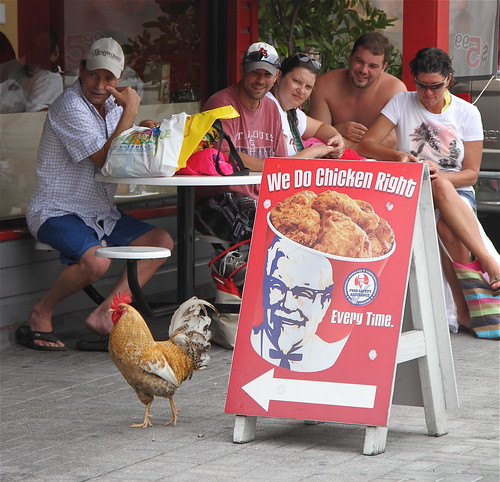General Discussion
Related: Editorials & Other Articles, Issue Forums, Alliance Forums, Region ForumsWhen chickens go wild
Nature Magazine:Opaekaa Falls, like much of Kauai, is teeming with feral chickens — free-ranging fowl related both to the domestic breeds that lay eggs or produce meat for supermarket shelves and to a more ancestral lineage imported to Hawaii hundreds of years ago.
These modern hybrids inhabit almost every corner of the island, from rugged chasms to KFC car parks. They have clucked their way into local lore and culture and are both beloved and reviled by Kauai's human occupants. Biologists, however, see in the feral animals an improbable experiment in evolution: what happens when chickens go wild?
The process of domestication has moulded animals and their genomes to thrive in human environments. Traits that ensure survival in the wild often give way to qualities that benefit humans, such as docility and fast growth. Feralization looks, on its surface, like domestication in reverse. But closer inspection suggests that the chickens of Kauai are evolving into something quite different from their wild predecessors, gaining some traits that reflect that past, but maintaining others that had been selected by humans. In this way, they are similar to other populations of animals, including dogs, pigs and sheep, that have broken free of captivity and flourished.
By looking at feral animals, some evolutionary biologists hope to determine how domestic animals and their genes change in response to natural pressures. The research could also help to inform tricky conservation questions about how such animals affect native species, and ultimately whether and how to control them.
But will science answer the real question: why do the chickens cross the road?

KamaAina
(78,249 posts)eppur_se_muova
(36,261 posts)mindwalker_i
(4,407 posts)Call Colonel Sanders RIGHT FUCKING NOW!
Oh wait...
jberryhill
(62,444 posts)




snooper2
(30,151 posts)eppur_se_muova
(36,261 posts)... the building across the street had a sign saying "veterinary hospital". ![]()
malaise
(268,966 posts)but most of those chickens have owners.
Quantess
(27,630 posts)The Big White Turkey and Big Bronze Turkey (I am going from memory here, so I could be mistaken. BWT and BBT is what I believe they are referred to, although it has been several years since I raised a turkey). Their bodies are far, far too big for their poor little feet.
http://extension.psu.edu/animals/poultry/topics/general-educational-material/the-chicken/modern-turkey-industry
hollysmom
(5,946 posts)I had wild turkeys living in my back yard for 6 weeks it was a living hell. Have you ever pulled up your dive way tonly to be surrounded by turkeys pecking at your window and staring at you, I was stuck there for a long time - if this ever happens to you, always carry an umbrella - turkeys are afraid of umbrellas opening and closing - it reminds them of animals puffing up for a fight. Without an umbrella, they are not afraid of people and will chase you down the street and those suckers can run!!! and can fly, they would sit in my trees, looking down on me, - now I always mow my back yard and never let the grass go to seed.
Quantess
(27,630 posts)My experience with raising turkeys consists of:
I walked into a farm store during "chick week" and spotted a tiny, bullied, Big White turkey chick with bloody sores, isolated. I asked an employee and she offered me the chick for free. I felt sorry for the chick and bought a Big Bronze turkey chick as a companion. We had a few chickens at the time.
The white one turned out to be a weakling in the flock. Apparently the other chicks had tried to peck her to death because they knew there was something wrong with her, I realized later. The white bullied chick I got for free was also a little dumber than the bronze chick I bought. But since the bronze turkey had only one turkey friend, they got along just fine. The bronze one occassionally pecked the white one. They were both hen turkeys, which occurred to us about a year later, due to the occasional giant eggs.
The white one became paralyzed and unable to walk about 8 months, and was taken by predators at about 1 year old. The bronze turkey hen was a nice pet, very friendly, and not dumb at all when compared to a chicken. But she had a giant body with tiny feet. She hobbled around the yard like an obese old man, slowly and with difficulty. She too was taken by predators at about 3 years of age.
Binkie The Clown
(7,911 posts)pinboy3niner
(53,339 posts)Ptah
(33,027 posts)pinboy3niner
(53,339 posts)Ptah
(33,027 posts)dembotoz
(16,802 posts)Lifelong Protester
(8,421 posts)where chickens can cross the road without their motivation being questioned......![]()
pinboy3niner
(53,339 posts)